
Projection Welding
Questions and Answers
This answer has been partially answered in a previous article for a 6 mm weld nut. The 8 mm weld nut would weld with similar values. The data can be found in the same referenced source. The question did not specify the weld material so an exact answer cannot be given.
The referenced article is:
WHAT IS A STARTING WELD SCHEDULE FOR A FOUR PROJECTION M6 WELD NUT TO 3 MM (0.117”) STEEL?

The Ohio Nut and Bolt Company website is a good source for projection nut welding data.
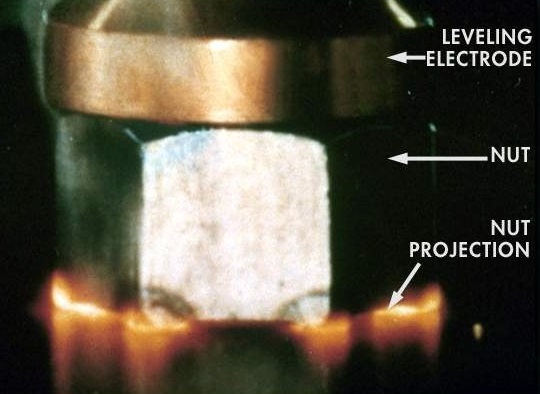
WELD NUT BEING WELDED
Use the above data and develop the proper settings for your application.
When setting up a new schedule always start with low power settings to avoid unexpected expulsion.
References: The Ohio Nut and Bolt Company
RWMA – Resistance Welding Manual 4th Edition
AWS Standard C1.1 Recommended Practices for Resistance Welding
Tapered electrodes are the most used system for attaching electrodes to their holders/tooling in spot welding. Tapers are frequently used in projection welding for attachment. The ease of changing electrodes is the reason for this. As long as the electrode can be removed by a simple twist of the removal tool tapers are the best choice.
This chart indicates the proper taper/electrode size or thread vs force.
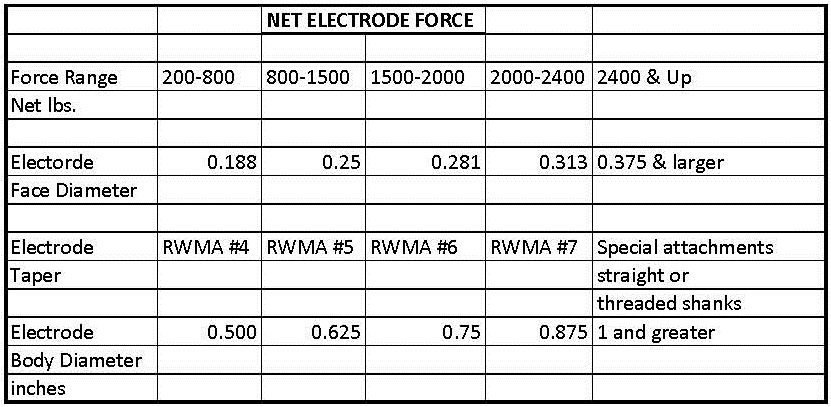
As the duty cycle or demand of the application goes up – force and heat. This my change and other attachments become better choices. The chart above shows that at 2400 pounds force tapered electrodes must be replaced with threaded or flanged electrode designs. Nut welding is a large user of threaded faced electrodes with locator pins. The forces, and heat make the tapered electrode not a good choice in many of heavy-duty nut weld applications. The threaded electrodes are easy to remove and refurbish and replace as desired. Tapered electrodes are used for nut welding but it comes down to how much heat and force they see. How often will the electrode need to be removed and how difficult will it be. If it only needs to be changed once a week that is great but if it won’t come out of the tooling ??? You have lost the entire fixture. Choose the tapered, threaded or flanged electrode system that can be removed with less difficulty.
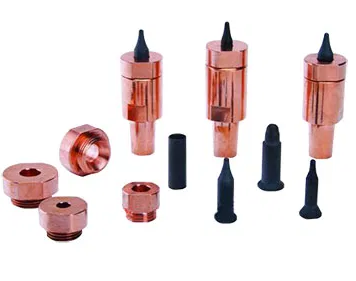
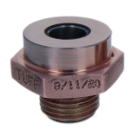
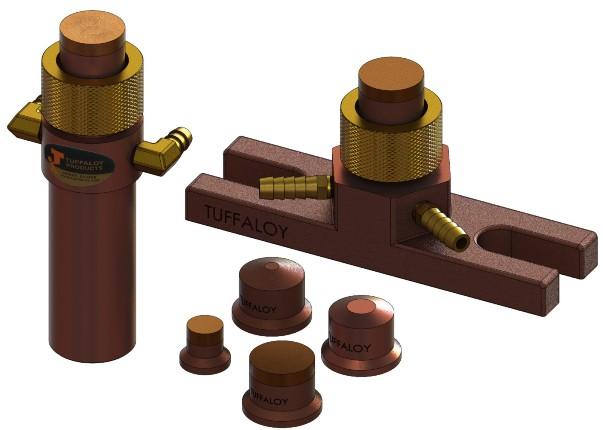
TAPERED NUT ELECTRODES THREADED WELD NUT FLANGED WELD SYTEM
All three systems can be alloy copper faced or copper/tungsten faced, with or without locator pins.
This discussion applies to more than nut welding. It can also apply to any projection welding if electrode wear and changing becomes an issue.
Contact your local welding distributor for advice in making the proper system choice.
Reference: RWMA Resistance Welding Manual 4th Edition
Tuffaloy Resistance Welding Products Catalog
Capacitor Discharge
A capacitor discharge welder is known to discharge its full output very quickly into the weld joint. The weld may be a ½ cycle or so. My knowledge of CD equipment is minimal. I can’t offer any comments on life or maintenance. I understand they can be more expensive to purchase as compared to AC.
AC
In comparison a standard AC welder makes a projection weld in several cycles 5 to 20 or more cycles. This is a much slower weld and may impart a different heat affect than the CD welder which is short and fast.
AC equipment is robust can operate for a very long time with little maintenance. Force, follow-up and alignment are the most important issues to keep an eye on.
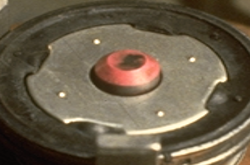
PROJECTION WELD PART
MFDC
Recently the MFDC segment of the market has been developing transformers with a “Fast Rise” to duplicate the Capacitor discharge. Their goal is to produce vary large weld currents in 10, 20 or 30 milliseconds. MFDC generates a DC output so the current can flow longer than an AC ½ cycle. They have been successful. This a promising new development.
Reference: RWMA Resistance Welding Manual 4th Edition
Nut welding is a very common operation in manufacturing. Hundreds of thousands of nuts are welded every day. Most are loaded and welded on automated lines. The tooling and fixtures include locating equipment to ensure the nut is positioned properly each time. In many cases a “Pin” is used to locate the hole in the nut and hold it in place. This pin frequently must be insulated to prevent current flow into the threads of the nut. If there is flow it will probably be an arc which will damage the threads.

AUTO NUT FEED COMPONENTS
Projection welding is a very widely used process from cross wire welding of fencing, to nut welding, to water tight water heater fittings, to a handle on a kitchen measuring cup. They all perform different important functions but all depend upon the shape of the part to concentrat the heat and power for nugget formation. The machine and electrodes have to hold the part in place for this to occur or we have chaos.
Factors that are important are the machine functions of pressure current and time. AWS covers general maintenance of the machine and will not be addressed here, see the reference.
Page 3 of 14
Have a Question?
Do you have a question that is not covered in our knowledgebase? Do you have questions regarding the above article? Click here to ask the professor.
